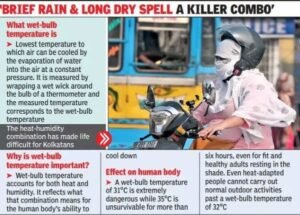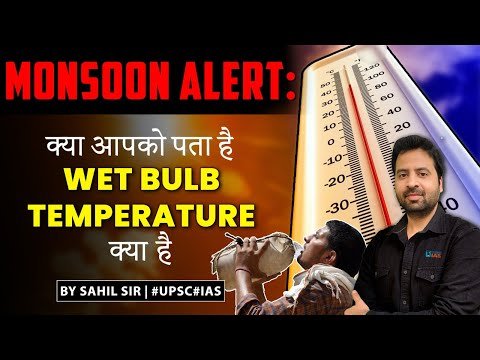Wet Bulb Temperature: Meaning and Significance | UPSC
- Context: In a summer of record-breaking heat in many places, air temperature isn’t the only thing that’s increasing, the amount of moisture in the air is also climbing.
- This brings into picture the importance of measuring the wet-bulb temperature.

Analysis
Dry Bulb Temperature
- When people refer to the temperature of the air, they are normally referring to its dry bulb temperature. The Dry Bulb Temperature refers basically to the ambient air temperature.
- It is called “Dry Bulb” because the air temperature is indicated by a thermometer not affected by the moisture of the air.
- Dry-bulb temperature can be measured using a normal thermometer freely exposed to the air (but shielded from radiation and moisture).
- The dry-bulb temperature is an indicator of heat content.
Wet Bulb Temperature
- Wet-bulb temperature is the lowest temperature to which air can be cooled by the evaporation of water into the air at a constant pressure.
- It is measured by wrapping a wet wick around the bulb of a thermometer and the measured temperature corresponds to the wet-bulb temperature.
-
- A piece of wet cloth is wrapped around the end of a thermometer to see how much evaporation can decrease the temperature.
-
- The rate of evaporation from the wet bandage on the bulb, and the temperature difference between the dry bulb and wet bulb, depends on the humidity of the air. The evaporation is reduced when the air contains more water vapor.
- Thus, the wet bulb temperature is always lower than the dry bulb temperature but will be identical with it at 100% relative humidity (the air is at the saturation line).
- Relative humidity is a measure of how much water vapor is in a water-air mixture compared to the maximum amount possible.
Significance of wet-bulb temperature
- Wet-bulb temperature accounts for both heat and humidity, unlike the standard temperature (dry-bulb) we see in weather forecasts which account only for heat.
- It reflects what that combination means for the human body’s ability to cool down.
- As the air around us gets more humid, our body is less able to sweat effectively, meaning we can’t cool off as successfully.
-
- When human beings feel hot, they cool themselves by sweating.
- However, if the humidity is too high, sweating no longer works and one risks dangerous overheating.
-
- That’s why dry heat feels more tolerable than extreme humidity and a humid heatwave is considered a lot more dangerous compared with a dry heatwave.
Effects on human body
- If the wet-bulb temperature reading is higher than our body temperature, it means that we cannot cool ourselves to a temperature tolerable for humans by evaporating sweat.
-
- That kind of temperature would make it impossible to sweat enough to avoid overheating, organ failure and eventual death.
-
- A wet-bulb temperature of 31 degrees Celsius is extremely dangerous. Even heat-adapted people cannot carry out normal outdoor activities past a wet-bulb temperature of 32 degrees Celsius.
- Theoretically, if wet-bulb temperature reaches 35 degrees Celsius, humans can no longer lose internal body heat by sweating and cool themselves. This could potentially leads to heatstrokes.
- Air conditioning is especially useful when the wet-bulb temperature gets high as it removes the humidity from the air.
- As the globe warms and bodies of water evaporate at higher rates than before, raising humidity levels, wet bulb temperatures will continue to rise.
Do you know?
- When ambient temperatures are high, the human body cools itself by regulating sweat.
- Water in the sweat evaporates by absorbing heat from the body.
- While the body controls the sweat glands, the rate of evaporation is limited by the saturation level of air.
- The closer the air is to being 100% humid, the slower the rate of evaporation, compromising the ability of the body to cool itself, thus causing heat stress.
References:
- https://www.washingtonpost.com/weather/2021/07/24/wet-bulb-temperature-extreme-heat/
- https://timesofindia.indiatimes.com/city/delhi/stroke-of-bad-luck-a-different-heat-to-worry-about/articleshow/84188711.cms
- https://timesofindia.indiatimes.com/city/kolkata/2-days-after-heavy-rain-wet-bulb-effect-makes-kolkatans-sweat/articleshow/93867082.cms
- https://www.weather.gov/source/zhu/ZHU_Training_Page/definitions/dry_wet_bulb_definition/dry_wet_bulb.html
Practice Questions:
Q. Consider the following statements:
Statement-I:
A humid heatwave is considered a lot more dangerous compared with a dry heatwave.
Statement-II:
As the air around us gets more humid, our body is less able to sweat effectively.
Which one of the following is correct in respect of the above statements?
(a) Both Statement-I and Statement-II are correct and Statement-II is the correct explanation for Statement-I
(b) Both Statement-I and Statement-II are correct and Statement-II is not the correct explanation for Statement-I
(c) Statement-I is correct but Statement-II is incorrect
(d) Statement-I is incorrect but Statement-II is correct
Answer: a
Explanation:
Wet Bulb Temperature
- Wet-bulb temperature is the lowest temperature to which air can be cooled by the evaporation of water into the air at a constant pressure.
- It is measured by wrapping a wet wick around the bulb of a thermometer and the measured temperature corresponds to the wet-bulb temperature.
-
- A piece of wet cloth is wrapped around the end of a thermometer to see how much evaporation can decrease the temperature.
-
- Wet-bulb temperature accounts for both heat and humidity, unlike the standard temperature (dry-bulb) we see in weather forecasts which account only for heat.
- It reflects what that combination means for the human body’s ability to cool down.
- As the air around us gets more humid, our body is less able to sweat effectively, meaning we can’t cool off as successfully. Hence, statement 1 is correct.
-
- When human beings feel hot, they cool themselves by sweating.
- However, if the humidity is too high, sweating no longer works and one risks dangerous overheating.
-
- That’s why dry heat feels more tolerable than extreme humidity and a humid heatwave is considered a lot more dangerous compared with a dry heatwave. Hence, statement 1 is correct.
Hence, both Statement-I and Statement-II are correct and Statement-II is the correct explanation for Statement-I.
Therefore, option (a) is the correct answer.
Relevance: A recent widely-accepted international study has shown that ‘wet bulb temperature’ of 35C could harm even young and healthy individuals.
Subject: Current Affairs | Science and Technology
Tags: Analytical | Moderate Difficulty
Mains Answer Writing Practice
Topic: Science and technology (GS Mains Paper 3)
- Q. Wet-bulb temperature is a better way to assess the risk to human health than just temperature. Explain. (Answer in 150 words)

